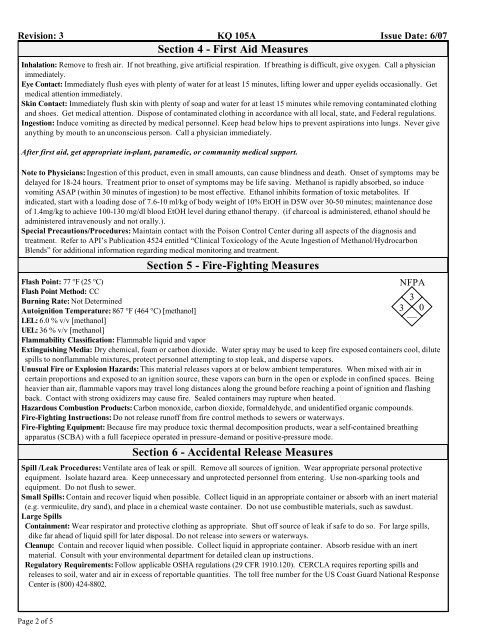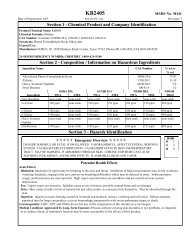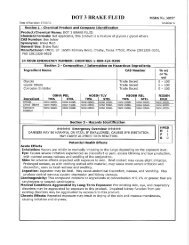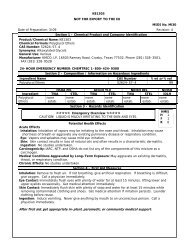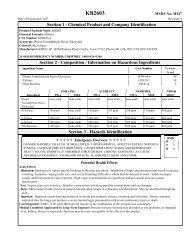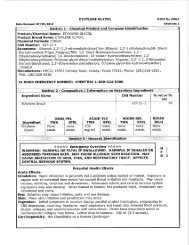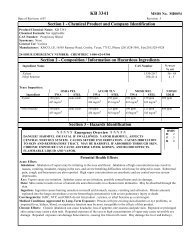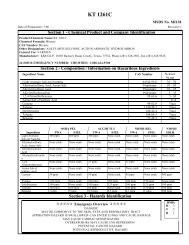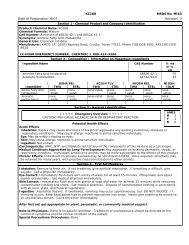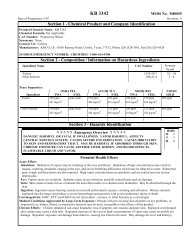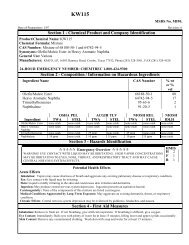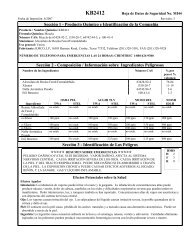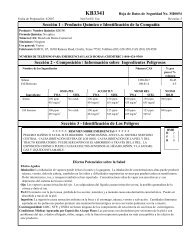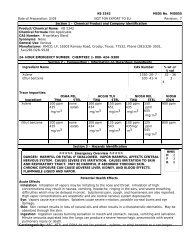Create successful ePaper yourself
Turn your PDF publications into a flip-book with our unique Google optimized e-Paper software.
Revision: 3 <strong>KQ</strong> <strong>105A</strong> Issue Date: 6/07<br />
Section 4 - First Aid Measures<br />
Inhalation: Remove to fresh air. If not breathing, give artificial respiration. If breathing is difficult, give oxygen. Call a physician<br />
immediately.<br />
Eye Contact: Immediately flush eyes with plenty of water for at least 15 minutes, lifting lower and upper eyelids occasionally. Get<br />
medical attention immediately.<br />
Skin Contact: Immediately flush skin with plenty of soap and water for at least 15 minutes while removing contaminated clothing<br />
and shoes. Get medical attention. Dispose of contaminated clothing in accordance with all local, state, and Federal regulations.<br />
Ingestion: Induce vomiting as directed by medical personnel. Keep head below hips to prevent aspirations into lungs. Never give<br />
anything by mouth to an unconscious person. Call a physician immediately.<br />
After first aid, get appropriate in-plant, paramedic, or community medical support.<br />
Note to Physicians: Ingestion of this product, even in small amounts, can cause blindness and death. Onset of symptoms may be<br />
delayed for 18-24 hours. Treatment prior to onset of symptoms may be life saving. Methanol is rapidly absorbed, so induce<br />
vomiting ASAP (within 30 minutes of ingestion) to be most effective. Ethanol inhibits formation of toxic metabolites. If<br />
indicated, start with a loading dose of 7.6-10 ml/kg of body weight of 10% EtOH in D5W over 30-50 minutes; maintenance dose<br />
of 1.4mg/kg to achieve 100-130 mg/dl blood EtOH level during ethanol therapy. (if charcoal is administered, ethanol should be<br />
administered intravenously and not orally.).<br />
Special Precautions/Procedures: Maintain contact with the Poison Control Center during all aspects of the diagnosis and<br />
treatment. Refer to API’s Publication 4524 entitled “Clinical Toxicology of the Acute Ingestion of Methanol/Hydrocarbon<br />
Blends” for additional information regarding medical monitoring and treatment.<br />
Section 5 - Fire-Fighting Measures<br />
Flash Point: 77 °F (25 °C)<br />
Flash Point Method: CC<br />
Burning Rate: Not Determined<br />
3<br />
Autoignition Temperature: 867 °F (464 °C) [methanol]<br />
3 0<br />
LEL: 6.0 % v/v [methanol]<br />
—<br />
UEL: 36 % v/v [methanol]<br />
Flammability Classification: Flammable liquid and vapor<br />
Extinguishing Media: Dry chemical, foam or carbon dioxide. Water spray may be used to keep fire exposed containers cool, dilute<br />
spills to nonflammable mixtures, protect personnel attempting to stop leak, and disperse vapors.<br />
Unusual Fire or Explosion Hazards: This material releases vapors at or below ambient temperatures. When mixed with air in<br />
certain proportions and exposed to an ignition source, these vapors can burn in the open or explode in confined spaces. Being<br />
heavier than air, flammable vapors may travel long distances along the ground before reaching a point of ignition and flashing<br />
back. Contact with strong oxidizers may cause fire. Sealed containers may rupture when heated.<br />
Hazardous Combustion Products: Carbon monoxide, carbon dioxide, formaldehyde, and unidentified organic compounds.<br />
Fire-Fighting Instructions: Do not release runoff from fire control methods to sewers or waterways.<br />
Fire-Fighting Equipment: Because fire may produce toxic thermal decomposition products, wear a self-contained breathing<br />
apparatus (SCBA) with a full facepiece operated in pressure-demand or positive-pressure mode.<br />
Section 6 - Accidental Release Measures<br />
NFPA<br />
Spill /Leak Procedures: Ventilate area of leak or spill. Remove all sources of ignition. Wear appropriate personal protective<br />
equipment. Isolate hazard area. Keep unnecessary and unprotected personnel from entering. Use non-sparking tools and<br />
equipment. Do not flush to sewer.<br />
Small Spills: Contain and recover liquid when possible. Collect liquid in an appropriate container or absorb with an inert material<br />
(e.g. vermiculite, dry sand), and place in a chemical waste container. Do not use combustible materials, such as sawdust.<br />
Large Spills<br />
Containment: Wear respirator and protective clothing as appropriate. Shut off source of leak if safe to do so. For large spills,<br />
dike far ahead of liquid spill for later disposal. Do not release into sewers or waterways.<br />
Cleanup: Contain and recover liquid when possible. Collect liquid in appropriate container. Absorb residue with an inert<br />
material. Consult with your environmental department for detailed clean up instructions.<br />
Regulatory Requirements: Follow applicable OSHA regulations (29 CFR 1910.120). CERCLA requires reporting spills and<br />
releases to soil, water and air in excess of reportable quantities. The toll free number for the US Coast Guard National Response<br />
Center is (800) 424-8802.<br />
Page 2 of 5


